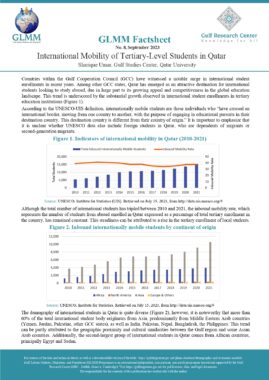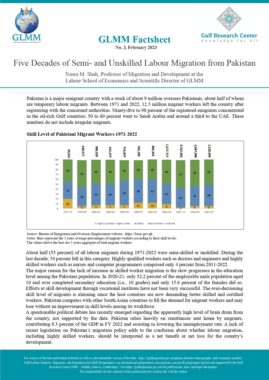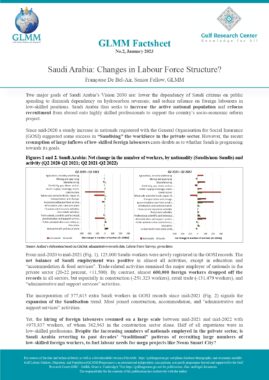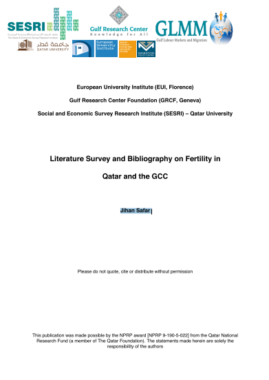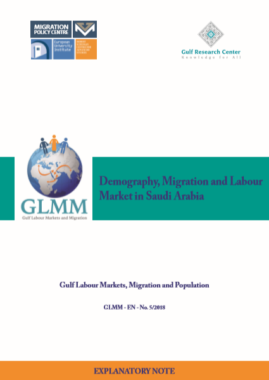GCC: Total population and percentage of nationals and non-nationals in GCC countries (national statistics, 2010-2017) (with numbers)
| date/ period | Total population | date/ period | Nationals | Non-nationals | % in total population | ||
| Country | Nationals | Non-nationals | |||||
| Bahrain (1) | mid-2016 | 1,423,726 | mid-2016 | 664,707 | 759,019 | 46.7 | 53.3 |
| Kuwait (2) | 31 December 2016 | 4,411,124 | 31 December 2016 | 1,337,693 | 3,073,431 | 30.3 | 69.7 |
| Oman (3) | 7 April 2017 | 4,599,051 | 7 April 2017 | 2,488,755 | 2,110,296 | 54.1 | 45.9 |
| Qatar (4) | February 2017 | 2,673,022 | April 2010 | 243,073 | 1,456,362 | 14.3 | 85,7 |
| Saudi Arabia (5) | May 2016 | 31,742,308 | May 2016 | 20,064,970 | 11,677,338 | 63.2 | 36.8 |
| United Arab Emirates (6) | mid-2010 | 8,264,070 | mid-2010 | 947,997 | 7,316,073 | 11.5 | 88.5 |
| Total* | 53,113,301 | 25,747,195 | 26,392,519 | 49.4 | 50.6 | ||
Sources: national institutes of statistics, latest year or period available as of 7 April 2017.
* Total provides the sum of population numbers at different dates. It is not exactly the total population at any of these dates.
1- Definition:
Non-nationals are:
1- persons bearing nationality of a foreign State other than the GCC State of residence, or bearing no proof of nationality from any given state (stateless persons and holders of refugee status and travel document in a third country) ;
2- Holders of residence permit residing in the given GCC country at date of census, as per definition of residence used in each of the countries.
Figures for Bahrain, Saudi Arabia and the UAE are estimates.
2- Sources of data:
(1) Bahrain Central Informatics Organisation (CIO), CIO’s website, “Statistics” and “Population” sections http://www.data.gov.bh/en/ResourceCenter
(2) Kuwait Public Authority for Civil Information (PACI), Statistical Reports, http://www.paci.gov.kw/en/
(3) National Centre for Statistical Information (NCSI), homepage as of 6 April 2017, https://www.ncsi.gov.om/Pages/NCSI.aspx
(4) Qatar Ministry of Development Planning and Statistics, homepage as of 6 April 2017, http://www.mdps.gov.qa/en/Pages/default.aspx; Qatar Statistics Authority (QSA), Census 2010, http://gulfmigration.eu/population-by-nationality-qatari-non-qatari-census-1970-2010/;
(5) Saudi Arabia General Authority for Statistics, Demographic Survey 2016, https://www.stats.gov.sa/sites/default/files/en-demographic-research-2016_4.pdf
(6) UAE National Bureau of Statistics (NBS)-now: Federal Competitiveness and Statistics Authority (FCSA), estimates. http://original.fcsa.gov.ae/EnglishHome/ReportDetailsEnglish/tabid/121/Default.aspx?ItemId=1914&PTID=104&MenuId=1
Similar Posts:
- GCC: Total population and percentage of nationals and foreign nationals in GCC countries (national statistics, 2010-2016) (with numbers)
- GCC: Total population and percentage of nationals and non-nationals in GCC countries (national statistics, 2010-2015) (with numbers)
- GCC: Total population and percentage of nationals and non-nationals in GCC countries (latest national statistics, 2010-2015)
- GCC: National and foreign national populations aged 15 and above by sex, and sex ratios in GCC countries (national statistics, 2010-2015)
- GCC:National and non-national populations aged 15 and above by sex, and sex ratios in GCC countries (national statistics, 2010-2016)
Tags: Bahrain, Foreign & National Populations, Foreign Population, Gulf Cooperation Council, Kuwait, National Population, Oman, Qatar, Saudi Arabia, United Arab Emirates

































